Article contents
Photoreceptor spectral absorbance in larval and adult winter flounder (Pseudopleuronectes americanus)
Published online by Cambridge University Press: 02 June 2009
Abstract
The habitat occupied by larval winter flounder (Pseudopleuronectes americanus) differs considerably in light regime from that of the adult. To understand how the visual system has adapted to such changes, photoreceptor spectral absorbance was measured microspectrophotometrically in premetamorphic and postmetamorphic specimens of winter flounder. Before metamorphosis, larval flounder retinas contain only one kind of photoreceptor which is morphologically cone-like with peak absorbance at 519 nm. After metamorphosis, the adult retina has three types of photoreceptors: single cones, double cones, and rods. The visual pigment in single cones has a peak absorbance at λmax = 457 nm, the double cones at λmax = 531 and 547 nm, and the rod photoreceptors at λmax = 506 nm. Double cones were morphologically identical, but the two members contained either different (531/547 nm) or identical pigments (531/531 nm). The latter type were found only in the dorsal retina. The measured spectral half-bandwidths (HBW) were typical of visual pigments with chromophores derived from vitamin A1 with the possible exception of the long-wavelength absorbing pigment in double cones which appeared slightly broader. Because the premetamorphic pigment absorbance has a different λmax than those of the postmetamorphic pigments, different opsin genes must be expressed before and after metamorphosis.
- Type
- Research Articles
- Information
- Copyright
- Copyright © Cambridge University Press 1993
References
- 45
- Cited by




